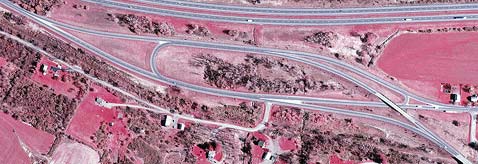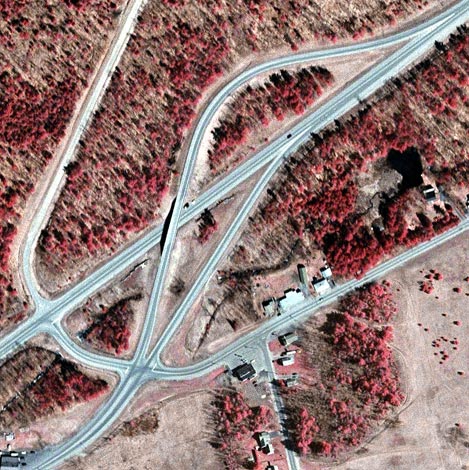 |
Introduction: In Part 1 of this feature, three interchanges were shown depicting various reasons for the upgrading of rural intersections into grade-separated interchanges. This week's examples share a common element, in that they all divide streams of traffic into two major paths. In other words, they are essentially high-powered forks in the road.
 |
Orientation: NY 14 runs top to bottom, while NY 14A branches off toward the left. At top, the two are connected by reference route 962C.
The interchange: At this point, northbound traffic out of
Watkins Glen may choose between two routes to Geneva. NY 14 remains
close by the shore of Seneca Lake, while NY 14A is a more local option,
serving Penn Yan and other communities in eastern Yates and Ontario
Counties. A simple two-way grade-separated split provides the
connection. Note that this is a semi-directional split: the left-hand
fork is reached via a right-hand exit. For those few vehicles requiring
the south-to-north U-turn movement, a short state highway (reference
route 962C) serves the purpose. There is even a single property having
access from the connector.
 |
Orientation: NY 5S runs from left to right, and NY 162 splits off toward bottom right. The New York State Thruway (I-90) is at top. The hamlet of Sprakers is to the right of this photo.
The interchange: Here, NY 162 descends the side of the Mohawk River valley to merge into NY 5S. NY 162 was moved off of local streets in Sprakers and provided with a higher-powered interchange connection. The split is grade-separated more because of topography than traffic volume. In this case, the interchange replaces a T-style junction rather than a fork, and so the U-turn movement through the split is more widely used. Both possible U-turns make use of a single ramp within the spread median of NY 5S at the west end of the interchange. Moreover, this example is fully directional, in that the left hand fork merges from the left into NY 5S, and the right-hand fork diverges to the right.
 |
Orientation: NY 374 is the straight diagonal highway from bottom left to top right. NY 3 is the more local road to the south.
The interchange: At this interchange west of Plattsburgh,
traffic patterns are more complex. NY 374 is a two-lane express highway
west from Plattsburgh, and serves northwestern points such as Dannemora
and Malone. NY 3 brings in traffic from Saranac Lake and the northern
Adirondacks. Motorists approaching Plattsburgh on NY 3 are instructed
to move onto NY 374 for faster access. A two-way split similar to that
at Reading Center handles this traffic. Also
similar to that junction, a short connector (reference route 970F)
serves the lower-volume U-turn movements. However, NY 3 also continues
eastward to serve local communities and, as is discernible above,
carries no small share of the traffic load. A crossroads intersection
therefore carries NY 3 through a right angle, with reference route 970F
opposite one leg of NY 3 and the ramps to and from NY 374 opposite the
other. A peculiarity here is that the ramps have each their own
reference route numbers: the eastbound ramp is route 970G and the
westbound is route 970F.
<< Back